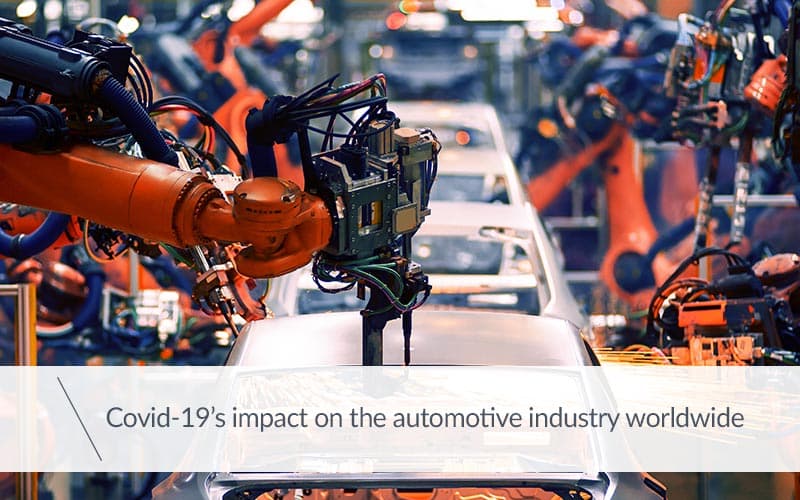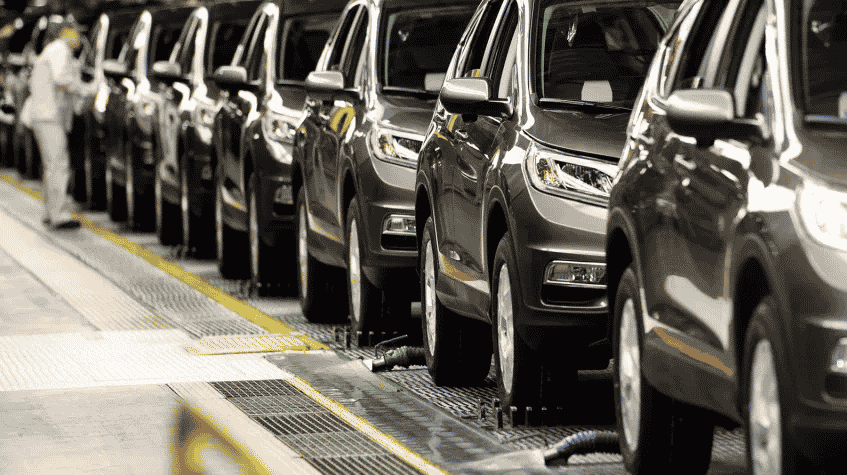The COVID-19 pandemic, which has been dubbed a “black swan occurrence,” has had a negative influence not only on people’s health but also on countries’ socio-economic activity around the world. To help flatten the epidemic curve, the governments of over 162 countries announced a complete shutdown of national and international borders, as well as travel restrictions and lockdown measures. The new coronavirus has far-reaching economic consequences around the world, and because of the global economy’s openness, it also had an impact on the automobile industry. Except that it halted global vehicle demand as well as the entire supply chain.
There was no one to manufacture or anything to make. As a result, the manufacturers and their suppliers shut down their operations for operational and hygienic concerns. However, because the automobile industry is a basic pillar of the economy, this has had a significant impact. The automobile industry had already experienced significant delays over the previous 12–18 months due to structural modification openings with the goods and services tax, axle-load reforms, shift to shared mobility, liquidity crunch, and other factors, and has been virtually idle since March 24 2020 due to the COVID19’s lockdown.
The examination of concerns and challenges encountered in the vehicle industry has been addressed in this study by projecting how the economy has changed in these sectors as a result of the COVID19. It also explains the tactics employed by the automobile industry to speed away from the uncertain turn.
The paper is standardized in the following way. The influence of COVID-19 is demonstrated in Section 2 by focusing on concerns and challenges in the automotive industry. Section 3 illustrates the strategies used by the automobile industry to solve those problems. Finally, in Section 4, the paper’s conclusion is discussed.
Sales
Automotive car sales have decreased overall. Following a study by Yan on consumer automobile purchase intentions, sales fell by 15% globally between the end of the first and second trimesters (more exactly, between March and May) of last year, a time when several nations throughout the world, including Italy, were experiencing lockdown and entire production blockages (2020). Many production plants around the world shut down during the pandemic for operational and hygienic reasons, and not a single vehicle left the assembly lines. A worldwide recession sparked a prolonged reduction of consumer demand as countries worked through various lockdown scenarios, resulting in widespread loss of consumer confidence, which had a substantial impact on automobile revenues and profitability. In terms of sales, a fall of 13.8 percent is expected from 2019 to 2022, extending a strong downward trend that began in 2018. The epidemic is undoubtedly to blame for this decline.
Suppliers
The outbreak of COVID-19 could be the most catastrophic event to hit the global economy in centuries, with long-term implications for the automobile sector supply chain. Auto suppliers rely heavily on immigrant labor, and their absence is expected to further delay the post-lockdown repair, causing a cascading effect throughout the assessment chain (Beredo, Denniston, Rathke & Giaimo, 2022). The pandemic has consequently impacted the automobile supply chain model, from sourcing raw materials to the production of finished products. Additionally, suppliers and OEMs facing liquidity issues may succumb to fading market conditions, producing widespread disruption throughout the automobile manufacturing network.
Research and development
Automakers and suppliers are seeking to shore up their finances by preserving cash and other non-critical expenses as sales activity grinds to a standstill in core markets and there is no promise for a rapid “return to normal” (Collie et al., 2022). This background, when paired with prospective legislative changes in important automotive fields such as e-mobility, autonomy, and connected vehicles, could have far-reaching consequences for technology implementation as well as short- and medium-term research investment objectives. This has resulted to a majority of businesses cutting back on R&D (research and development) to preserve core processes and maybe recoup growth in mobility technology and alternative fuels.
Auto dealers
Automobile dealerships have had significant issues. Dealers in the vehicle retail sector have been unable to respond quickly enough to shifting market conditions. For instance, in India, there are currently 15,000 or more automobile dealers selling two, three, and four-wheelers. During the lockdown time, they were unable to transfer automobiles (Nayak et al., 2021). Auto dealers have been advised that 30–45 days of completed goods records will be available, with prices expected to be significantly lower than before the lockout. It’s safe to assume that at least 8%–10% of these dealerships will close in the following six months. This decline is unquestionably due to the epidemic.
Mitigation Measures
In the face of the pandemic, automakers and lenders from all over the world have learned some unpleasant truths about their businesses. While the current situation may appear dire, it may offer businesses the impetus they need to rethink their current supply strategy and implement new, more protective models, while also taking short-term risk mitigation measures. Below, we will highlight major opportunities that the pandemic has revealed to the automobile industry for survival and loss mitigation purposes.
Risk Management Plans on operations and supply chain
Automobile suppliers should establish and implement a solid supply chain risk management strategy focused on business continuity as soon as possible, if not already done. These measures should include geographically diversifying supply chains to reduce reliance on individual suppliers, obtaining multi-sourced critical commodities to reduce dependency on individual suppliers, and establishing inventory systems to mitigate supply chain disruption. Additionally, two-tier and three-tier dealers are projected to be the most affected by epidemic-related disruptions, according to automakers with global supply chains (Carlier, 2022). Enhancing lines of communication and chain visibility are two initiatives that can be taken to identify possible problems earlier and work on remediation plans.
Workforce
According to the Bureau of Labor Statistics, automakers and suppliers in the United States employed over one million people. The well-being of employees should be a top priority for business leaders. The pandemic has caused a great blow to the health of most of the workers and this has consequently resulted in a severe reduction in the capability of automobile manufacturers (Accenture 2020). Since a potential v-shaped recovery will require an engaged workforce, the sector should focus on employee safety and care. Furthermore, companies have also been pushed to implement additional digital communication tools as a result of Covid-19. Video conferencing, messaging software, project management tools, desktop integration, and mobile capabilities have all been and continue to be opportunities for automotive companies to improve internal efficiency. Additionally, in order to maintain more workforce management flexibility during the epidemic, several firms are increasing their usage of contingent workers. These are trends that may be capitalized upon, and they provide an opportunity for the car industry to adopt whole new techniques.
Embracing e-commerce
During the pandemic, when dealerships around the world scrambled to meet evolving in-person restrictions, the technology proved invaluable. Some dealers closed their sales floors to the public and engaged with customers over the phone, via videoconference, or by special appointment only. According to research, the percentage of consumers who shop online for 50% or more of their entire purchases increased from 25% to 80% during the Covid-19 crisis (Knobbe & Proff, 2020). Potential buyers could also take advantage of sites and apps that helped them explore and arrange related services, such as financing and insurance, remotely and virtually as part of the car-buying process. It is therefore very clear that the coronavirus provides an opportunity for the car sector to continue to improve its digital selling capabilities in order to keep up with current market conditions.
Challenging the existing models
The automobile industry has had technology solutions and resources on hand for a long time, and now is the time to use them all. For example, the epidemic has accelerated the use of digital auditing for floor designs, minimizing the need for physical stock audits and saving dealerships money (Powell, 2022). The automotive sector has also implemented better operating models that are compatible with scalable and adaptive applications and can alleviate pandemic-related issues. Moreover, the pandemic shattered significant work trends, this has forced automotive HR directors to adjust to digital vs. on-site management.
New Financial Projections
While it may be tough to swallow, automobile companies must recast their operating cash flow predictions. This entails adjusting assumptions, estimates, and business plans to account for the new deflated market (Mylenka, 2022). It is vital to make current estimates that reflect the best and worst possibilities for the next several months and longer. Making excellent operational and managerial decisions requires revising forecasts that take into account the present environment and the effects of manufacturer shutdowns. In this vein of either best or worst possibilities, retaining enterprise value by hiring experienced legal and financial advisors early on can provide credibility when dealing with lenders, trade creditors, and investors.
Protection of the cashflow
In the short term, the COVID-19 outbreak and the resulting economic uncertainties have resulted in lower consumer requirements, resulting in slowed sales of new vehicles and delayed payments for additional maintenance (Rajamohan, Jenefer & Sathish, 2021). The disruption of the vehicle supply chain could cage money that could be used to provide employee relief and support. Because of these factors, intended cash may be inactive in the market for an extended period of time; nevertheless, new tactics can be devised to help mitigate the sliding effect. Companies are encouraged to seek expert public policy advice to help them navigate government funding programs and maximize their chances of receiving funds. Additionally, companies should also optimize working capital and seek strategies to generate immediate, measurable cash flow gains, such as continuing to invest in research and development.
We can conclude that in the early months of the global COVID-19 outbreak, the global economy slammed on the brakes. Similarly, the pandemic has impacted practically every business, including the globally interconnected car industry. Factory closures, supply chain disruptions, and decreased demand have all had an impact. As a result, several car dealerships have permanently closed, leading the car industry to decrease. We have provided a full explanation of the impact of COVID-19 on the automobile industry due to supply chain and transportation disruptions in this study. We’ve also detailed the methods that these industries would employ, as well as the measures and regulations put in place by the sector to deal with the economic disruption.
Works Cited
Accenture . (2020). Retrieved from https://www.accenture.com/_acnmedia/PDF-121/Accenture-COVID-19-Impact-Automotive-Industry.pdf
Beredo, C., Denniston, k.,Rathke, s., & Giaimo, c. (2022). Impacts to Automotive Supply Chains from COVID-19. Retrieved 21 May 2022, from https://www.globalsupplychainlawblog.com/automotive/impacts-to-automotive-supply-chains-from-covid-19/
Carlier, M. (2022). Topic: Impact of COVID-19 on the automotive industry worldwide. Retrieved 22 May 2022, from https://www.statista.com/topics/8749/impact-of-covid-19-on-the-automotive-industry-worldwide/#topicHeader__wrapper.
Collie, B., Wachtmeister, A., Waas, A., Kirn, R., Krebs, K., & Quresh, H. (2022). COVID-19’s Impact on the Automotive Industry. BCG Global. Retrieved 22 May 2022, from https://www.bcg.com/publications/2020/covid-automotive-industry-forecasting-scenarios.
Knobbe, F., & Proff, H. (2020). Dynamic capabilities in the automotive industry under digitalisation – a quantitative study in the automotive supplier industry. International Journal Of Automotive Technology And Management, 20(4), 436.
doi: 10.1504/ijatm.2020.10034373
Mylenka, T. (2022). Retrieved 22 May 2022, from https://apps.who.int/iris/bitstream/handle/10665/345300/WHO-HWF-WorkingPaper-2021.1-eng.pdf
Nayak, J., Mishra, M., Naik, B., Swapnarekha, H., Cengiz, K., & Shanmuganathan, V. (2021). An impact study of <scp>COVID</scp> ‐19 on six different industries: Automobile, energy and power, agriculture, education, travel and tourism and consumer electronics. Expert Systems, 39(3). https://doi.org/10.1111/exsy.12677
Powell, J. (2022). The global impact of Covid-19 on the automotive industry.Retrieved 22 May 2022, from https://www.soprabanking.com/insights/the-global-impact-of-covid-19-on-the-automotive-industry/
Rajamohan, S. , Sathish, A. , & Rahman, A. (2020). Impact of COVID‐19 on stock price of NSE in automobile sector. The International Journal of Advanced Multidisciplinary Research, 7(7), 24–29.
Yan, Y. , et al. (2020). An empirical study on consumer automobile purchase intentions influenced by COVID‐19. Available at SSRN 3593963.


